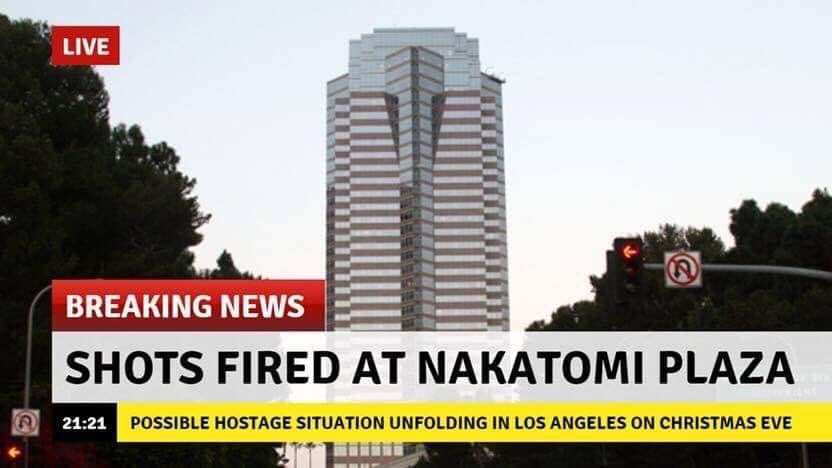 Thirty three years ago today, the United States was forever changed by the deadliest foreign terrorist attack on the country up to that time. Though the body count is still debated today, at least a dozen local, state and federal law enforcement officials were killed, as well as two of the hostages and all of the terrorists during the 1988 seizure of Nakatomi Plaza in Los Angeles. Some put the body count as high as 26.
Thirty three years ago today, the United States was forever changed by the deadliest foreign terrorist attack on the country up to that time. Though the body count is still debated today, at least a dozen local, state and federal law enforcement officials were killed, as well as two of the hostages and all of the terrorists during the 1988 seizure of Nakatomi Plaza in Los Angeles. Some put the body count as high as 26.
Significant confusion about the nature of the attack still swirls: was it an actual terrorist attack by a group sponsored from behind the Berlin Wall on a symbol of international capitalism? Was it an elaborate robbery? Or was it an attack on the holiday by a bunch of godless communists intent on winning the nascent War on Christmas? While we may never know the true motivation of the terrorists, largely recruited from West Germans who had distinctively Hollywood tastes, the incident is relived in households every December.
What we do know is harrowing: the terrorists took control of Nakatomi Plaza after most companies had shut down business for the holiday weekend. The Japanese company Nakatomi Corporation, however, insisted their employees come in on Christmas Eve, a Saturday, to finish a major deal. Taking advantage of the empty building, the terrorists seized about 30 Nakatomi employees, including a woman who was nine months pregnant, celebrating the holiday and the deal close.
The attack was well organized, with the terrorists armed with automatic weapons, plastic explosives and even missiles. To show their seriousness, the terrorists killed two of their hostages: Joseph Yoshinobu Takagi, the head of Nakatomi’s US operations, and Harry Ellis, a sales executive. The terrorists made demands to release compatriots from other worldwide leftist organizations, although historians question the sincerity of that demand.
However, New York City police detective John McClane–vacationing in Los Angeles to visit his family who had moved to the West Coast earlier in the year–evaded capture in the tower, and set off to thwart the terrorists. Communicating with a pudgy LAPD officer named Al Powell, who had been assigned to desk duty after killing a child playing with a toy gun, McClane took controversial actions to impede the terrorists, killing many of them, including dropping one out a window from the 30th floor. (Witnesses on the ground were concerned at the time that the defenstered individual was a hostage.)
Critics say McClain’s actions endangered the lives of the hostages and police on the ground. The FBI contends two of its agents–FBI Agents Johnson (no relation)–lost their lives in a rescue attempt because of McClane’s recklessness that resulted in the roof of the Tower exploding, destroying two helicopters. The LAPD also claims that McClain was responsible for the death of sales executive Ellis, having listened to the man’s execution via a walkie-talkie. LAPD officials also state McClane caused millions of dollars of damage to the building, including requiring thousands of screen doors to be replaced.
The unlikely hero of the attack was a young limousine driver known only as Argyle, who gained redemption after a childhood of thievery, including a 1980 incident at Ray’s Music Exchange in Chicago where he attempted to steal a guitar, only to be stopped by a gunshot by the blind store owner. (Authorities opted to not charge Ray for the use of a firearm in stopping the robbery, even though there were about 10 members of a blues band in the store at the time.) Reportedly, Argyle thwarted the terrorists’ getaway by damaging the imitation ambulance the terrorist intended to use to flee during the confusion of the aftermath.
To this day, myriad questions remain unanswered: What ever happened to the 13th terrorist, a Black American known only as “Theo” who was in the ambulance when it was destroyed by Argyle? How did the group obtain such an arsenal without authorities noticing? And why was the attack never mentioned by authorities?
Some people say that the Reagan Administration, with less than a month to go before leaving office, intentionally swept the incident under the rug in an effort to protect the coalition government of then-West German Chancellor Helmut Kohl. Rumors that Oliver North provided the weapons to the terrorists were persistent but have yet to be proven definitively. Tens of millions of dollars in bearer bonds–part of more than $600 million in securities held in the Nakatomi safe–went missing after the attack.
Curiously, on-site law enforcement officials let the key witness to the entire event, John McClane, drive off in a limo–driven by Argyle–with his wife immediately after the attack without questioning him or his wife. McClane would go on to have a spectacular law enforcement career, but one that strangely put him in a number of deadly situations, including one two years later where he had to act to thwart a terrorist takeover of Dulles Airport.